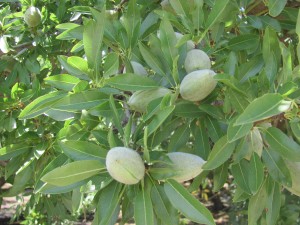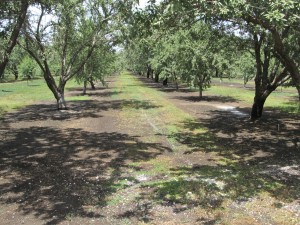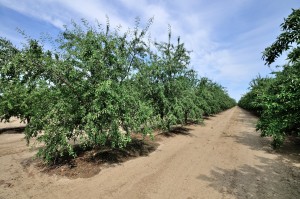
Director, Member Relations
This report covers conditions and observations made between Monday, May 4 and Sunday, May 31, 2015. The next report is scheduled for Monday, June 29, 2015.
Northern Region –
Mild conditions dominated the Sacramento Valley’s weather during the period, reducing the orchard’s moisture requirements, allowing the crop to develop relatively stress free. Daily maximum temperatures dropped from the upper 70’s in the period’s opening days to the upper 60’s and lower 70’s by mid-month, as clouds rolled over the region from storm systems spinning over Nevada. Readings then gradually increased, reaching their greatest values in the period’s closing days in the upper 80’s and lower 90’s. Meanwhile, morning lows were widely reported in the upper 40’s to lower 50’s throughout the period. While the weather systems lying east of the region promoted the reduced temperatures, the more northerly location of the Sacramento Valley prevented the more widespread rain received in the San Joaquin Valley from reaching the region’s orchards, with only a few hundredths of an inch reported.
Observers are reporting that the crop developed nicely during May, benefitting from the mild conditions. Kernels of all varieties are now completely solidified, or nearly so and have reached their maximum weight. Coincident with the mild temperatures, growers were able to scale back irrigations during the period, thus saving water while not impacting the developing nuts. As shown in the accompanying photo, some growers along the west side of the region have been pumping water into the Tehama-Colusa Canal, moving it to other properties they own; in some cases, lifting the water uphill.
Orchards in the region are in generally good condition with little evidence of disease at this time. Growers have been treating to prevent Scab and Rust infections, applications that must be made prior to infection in order to be effective. Some have also begun treatments with preventative miticides, targeted at the most damaging species of spider mites that can promote premature defoliation of the trees.
Growers are also monitoring populations of Navel Orange Worm (NOW) using pheromone traps to attract male moths and egg traps to monitor egg laying by females. Many in the region are speculating on the potential for an early hull split this year, given the apparently advanced stage of development. Some have noted that they were also expecting an earlier than normal timing in the 2014 crop and skipped treatments for NOW in the hopes that an early harvest would reduce losses. For many, that strategy failed, resulting in excessive damage levels in the 2014 crop. Growers and their Pest Control Advisors will be watching crop and insect cycles closely in the coming weeks in an effort to avoid the damage suffered in 2014.
Central Region –
Relatively mild conditions reign over the central region during May, giving both the orchards and the growers a bit of a break. Daily maximum temperatures ranged from the upper 60’s to the upper 80’s for nearly all of the month, with readings rising into the mid 90’s in the final days of the period. Meanwhile morning low readings were reported uniformly between the mid 40’s and lower 50’s throughout the month. Clouds moved over the region on several days during the period, approaching from the east, over the Sierra Nevada Mountains, rather than from the Pacific, as is normally the case. In addition to providing accent to the sky, the cloudy skies also brought rain to the region on May 7th and 14th, with total accumulations varying from just a trace to as much as one-half inch from several heavy downpours.
Crop development continues in the central region, aided slightly by the relatively cool temperatures experienced over the past few weeks. The lower temperatures experienced during May provided a bit of a respite by reducing the orchards moisture demands, allowing growers to delay and/or shorten irrigations. Rainfall in those area receiving the greatest amounts provided a “good news/bad news” situation, helping to reduce the potential populations of web spinning mites that may have been accumulating, while also increasing the potential for Scab and Rust in plantings that may not have received treatments to prevent the development of summertime foliar fungal infections. As a result, growers were evaluating the potential for infection during the latter portion of the period, with some opting to begin treatments in order to prevent the spread of infection during the coming weeks.
While some growers were also evaluating populations of Leaf-Footed Plant Bugs remaining in their orchards, all in the region remain acutely focused on the availability of water needed to bring their crop to harvest. Many with reduced supplies of “surface water” from their local irrigation districts have been forced to rely increasingly on ground water from their own wells and from ground water supplied by their district. Impacts in areas of the region drawing poor quality ground water have begun to manifest themselves. Orchards receiving water with elevated pH levels are displaying a yellowish cast while those receiving water with excessive salinity levels are displaying characteristic “burned” leaves and premature defoliation. Fortunately, these symptoms are confined to a relatively small area of the region, mostly along the I-5 corridor.
Observers are reporting notable variation in apparent crop yields, with some plantings bearing visually heavily laden trees while other plantings, in some cases adjacent to each other displaying much weaker apparent yields. The variation in apparent crop yield complicates growers’ fertility programs, with orchards bearing heavier crops requiring additional consideration.
While still almost two months from harvest, growers spent much of the period working to maintain the floor of the orchards. Those with established plantings have been mowing vegetation to reduce the amount of residue remaining on the surface at harvest. Those younger plantings that will be harvested for the first time are also scraping and smoothing the floor of their orchards to ensure that they will be able to pickup all of the nuts during the harvest.
Southern Region –
Growers in the southern San Joaquin Valley experienced variable conditions during May, with cloudy skies bringing rain to the region on several days. Daily high temperatures increased gradually during the period, varying predominately between the lower 70’s and lower 80’s for much of the month. However, readings increased during the last week of the month, reaching into the mid 90’s in all areas of the region. Morning low readings exhibited much more stability, with readings reported between the upper 40’s and upper 50’s. As previously noted, rain fell throughout the region as clouds rolled in from weather systems east of the state, dropping a total of a few hundredths of an inch to as much as 0.75 inch over several days.
The mild conditions of the past few weeks provided orchards in the southern San Joaquin with a bit of a respite, reducing water consumption and allowing growers to delay or shorten irrigations. While saving a bit of water in the process, water remains a focal point for all growers in the region. Observers are reporting that growers were largely able to meet their orchard’s water requirements during the month. However, visual impacts are becoming more apparent, with yellowing from poor quality water and excessive stress in instances of insufficient water becoming more visible in all areas of the region.
While monitoring moisture levels, growers have also been scrutinizing insect populations. Observers are reporting that Navel Orange Worm pheromone traps, used to monitor the life cycle development of this serious pest have been catching significant numbers of male moths. University advisors have also noted the potential for serious damage this year, resulting from poor “mummy” shaking conditions during the winter, leaving an excessive number of over-wintering larvae in the orchards. All in the region are expecting the hull split to begin at an earlier than normal date this year, due to the elevated temperatures experience in the weeks following the completion of the bloom. As a result, growers are especially vigilant this year, hoping to time any required treatments as accurately as possible with the proper stage of crop and insect development in order to minimize damage to the crop.
Growers have initiated treatments for web-spinning mites, using preventative materials targeted at damaging species, as well as applications to prevent summer foliar diseases. The rain events experienced during the period have increased the potential of Scab and Rust, which can cause significant defoliation if unchecked. Treatments for these fungal diseases must be completed prior to infection in order to be effective.
Over the coming weeks, growers will be working to prepare their orchards for the upcoming harvest. As can be expected, moisture management will play a critical role in order to bring the crop to maturity, as growers balance limited water supplies against the needs of the crop.